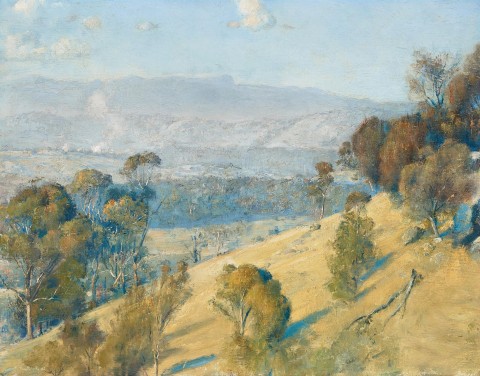DANDENONGS LANDSCAPE, 1925
TOM ROBERTS
oil on board
35.0 x 45.5 cm
signed and dated lower left: Tom Roberts ’25
bears inscription on old label verso: THIS PICTURE IS THE PROPERTY OF R.W. ROBERTS / N.J. Roberts
Caleb Grafton Roberts, Melbourne, the artist’s son
Thence by descent,
Norah Joan Roberts, Melbourne,
Thence by descent,
Richard William Roberts, Melbourne
Private collection, Melbourne
Joseph Brown Gallery, Melbourne, 1977
Private collection, New South Wales
Private collection, Sydney
Winter Exhibition 1977: Recent Acquisitions, Joseph Brown Gallery, Melbourne, 4 – 14 July 1977, cat. 33 (illus. as ‘Australian Landscape, 1923’)
Topliss, H., Tom Roberts: A Catalogue Raisonné, vol. I, Oxford University Press, Melbourne, 1985, pl. 221, cat. 563 (illus. as ‘Untitled. Dandenongs Landscape, 1923’)
As the golden summers of Australian Impressionism gave way to bronzed autumns, Tom Roberts and Arthur Streeton moved their focus from Heidelberg to the Dandenong Ranges, outside Melbourne. After diversions abroad, the neighbouring hills and valleys became their ‘Australia Felix’. Streeton acquired land at Olinda in 1921, then lived there. From years in England, Roberts returned to Australia in 1923, he and his wife Lillie settling at Kallista. They named their place ‘Talisman’ after their son Caleb’s house in Essex. Here Roberts painted a number of lyrical landscapes, among the finest being The South Wind, 1924, in the collection of the National Gallery of Australia, Canberra and Sherbrooke Forest, 1924, in Sydney’s Art Gallery of New South Wales. Compositional accents are strong, the tall, slender gums, verticals of The South Wind, reaching a crescendo in Sherbrooke Forest, offset by the flow of hill lines in one, rising curves in the other. Continuing in the lyrically atmospheric Dandenong Landscape, 1923, Roberts painted the moment with the afternoon sun at his back, shadows beginning to lengthen. Luminous, elevated through the grandeur of the panorama, stillness and balance disrupted only by the strong diagonal, corrected in the accent of gums, they are touched with gold as they stand sentinel over beauty. When Roberts exhibited a number of recent works at The Fine Art Society’s Gallery in September 1924, their ‘poetry’ won the applause of the reviewer for The Age, ‘peace and plenty’ for The Argus.1 For Sydney and his 1926 exhibition, it was his ‘sense of atmosphere’ that attracted attention.2
Recollection shared with renewal, Roberts’ response to the landscape is so richly tangible it gives this and other later works a special quality. Observed and admired by his fellow artist Jessie Traill (1881 – 1967), she wrote: ‘he made a lovely place in a lovely setting … There in the quiet of the years that followed he painted, thought-out gentle landscapes – they seemed removed from hurry; they had a joy and love in them, gained after years of seeking – our own bush interpreted by one who loved it so’.3
As conservationists, Roberts and Streeton took a particular interest in the environment. They celebrated the gum tree, the mighty forest giants. In 1921 Streeton had written to Roberts describing enthusiastically the scene at Olinda where he was later to live: ‘10 fine Blackwoods, most beautiful trees (and the blossom, as you know, a soft yellow, like pale butter)’.4 Roberts’ 1924 exhibition included a work he titled ‘Joy o’ Gums’. The drama of their destruction is felt in Streeton’s Last of the Messmates, 1928, in a private collection. Living and dead gums are contrasted across the very picture plane of Roberts’ The South Wind. For Dandenong Landscape, a fallen gum to the right precipitously echoes the shadows of other trees and diagonal of the hill, warning of the slide into environmental destruction. A gentle grandeur prevails.
1. The Age, Melbourne, 17 September 1924, p. 16 and The Argus, Melbourne, 17 September 1924, p. 16
2. Sydney Morning Herald, Sydney, 14 June 1926, p. 16
3. Traill, quoted in Gray, A., Tom Roberts, National Gallery of Australia, Canberra, 2015, p. 300
4. Letter to Roberts, 13 August 1921, Croll, R. H. (ed.), Smike to Bulldog: Letters from Sir Arthur Streeton to Tom Roberts, Ure Smith Pty Limited, Sydney, 1946, p. 105
DAVID THOMAS
